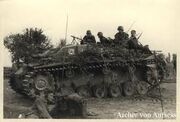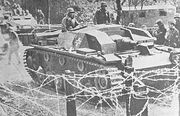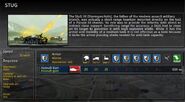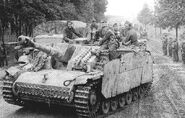The Sturmgeschütz III Ausf. A (in-game: StuG) is not generally considered to be a true tank because it lacks a turret. The gun was mounted directly in the hull, in a casemate-style fashion, with as low a profile as was possible to reduce vehicle height, and had a limited lateral traverse of a few degrees in either direction. Thus the entire vehicle had to be turned in order to acquire targets. Omitting the turret made production much more simpler and less costly, enabling greater numbers to be built. The lower vehicle height was meant to give a StuG designated vehicle a significantly shorter vertical profile as compared to contemporary tanks, making the StuG more difficult to hit and easier to protect in hull defilade.
The StuG Ausf. A is quite different from the StuG generations, it was equipped with Krupp's short-barelled 75 mm StuK 37 L/24 cannon and being an assault gun instead being a Tank Destroyer like it's kind.It should only be used early on to provide artillery support but would be outclassed by better tanks, so an upgrade to the Sturmtiger is necessary.
History

After defeat in World War I, German military commanders required mobile armored artillery units able to provide close infantry support. Colonel Erich von Manstein recommended the concept of infantry Begleitbatterien (escort batteries) to General Beck, Chief of the General Staff in 1935. He described how it should not be used as one uses a tank, rather as a unit directly involved with infantry advance to destroy fortified objectives through direct fire. Its primary mission is to strike and destroy enemy machine gun nests and tanks and then move out before it can become a target for enemy tanks.
Daimler-Benz AG was given the order to develop and produce just such a weapon on June 15, 1936. They created five prototypes, based on the chassis of the Panzer III, which were not useful for combat operations but did prove valuable for training.
Operational history

The first production units, the Sturmgeschütz III Ausf. A, arrived in 1940 mounted with the 75mm StuK 37L/24 gun and increased frontal hull armor (from 30mm to 50mm). Most assault guns were mounted on the chassis of a Panzer III or Panzer IV, with the resultant model being called either a StuG III or StuG IV, respectively.
Overall, the Sturmgeschütz series assault guns proved very successful and served on all fronts as assault guns and tank destroyers. Although Tigers and Panthers have earned a greater notoriety, assault guns collectively destroyed more tanks. Because of their low silhouette, StuG IIIs were easy to camouflage and a difficult target to annihilate. Sturmgeschütz crews were considered to be the elite of the artillery units. Sturmgeschütz units claimed to have knocked out 20,000 tanks by 1944. As of April 10, 1945, there were 1,053 StuG IIIs and 277 StuH 42s in service.
Strategies and Tactics
- The StuG is best used in groups of two or more, as by itself it can be somewhat inaccurate and not as powerful.
- It has little capability against enemy tanks, especially in the later years. The StuG should be accompanied with tanks and/or fighter support for protection.
- If a group of these approach an enemy structure undetected (in the case of Radio Silence being placed on that sector) and then fire simultaneously fire at a structure, the building will be reduced to rubble in a matter of seconds.
- The StuG is quite vulnerable to fighter-bombers and medium tanks, although some early-war light tanks such as the T-26 and lightly armored tank destroyers can be repelled by the main gun.
Weapons
| Weapon | ||||||||||
|---|---|---|---|---|---|---|---|---|---|---|
Assault Gun |
25 | 25 | 25 | 5 | 3 | 1 | 1 | 0 | 650 m |
Gallery
See Also
 Wikipedia: Sturmgeschütz
Wikipedia: Sturmgeschütz Wikipedia: Sturmgeschütz III
Wikipedia: Sturmgeschütz III- Sturmtiger - Upgrade
- M75 - Italian assault gun
| ||||||||||||||||||||||||||


